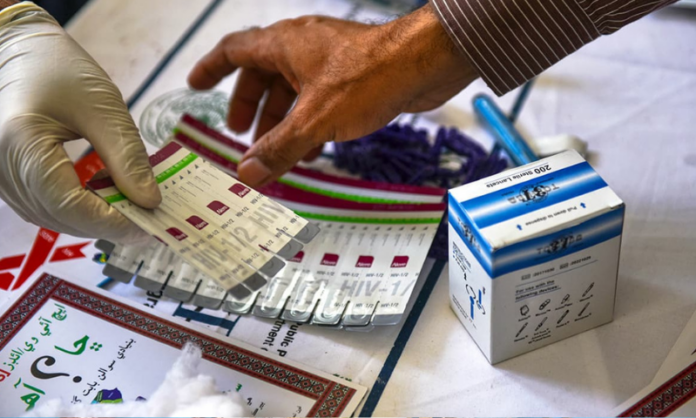کراچی میں 1،282 افراد میں ایچ آئی وی کی تشخیص ہوئی
According to officially released provincial figures, the number of blood-borne and sexually transmitted diseases is extremely low, and experts have called on the government to conduct blood tests in both the public and private sectors. Improve services and provide them with deep discounts.
According to the report, it was referring to data released by the Sindh Blood Transfusion Authority (SBTA) that said 24,088 people were found to be suffering from one or more infectious diseases and their samples arrived after blood tests. blood donors at blood banks in 24 districts during the first eight months of 2021, after which their donations were disqualified.
A total of 455,742 samples were analyzed in the province.
According to the data, HIV infection was detected in 1,357 people, while 8,155 required donors were confirmed to have hepatitis B and 7,995 people were found to be infected with hepatitis C.
Additionally, 6,142 donors were found to be infected with syphilis, a sexually transmitted infection.
A total of 448 blood donors were found to be infected with malaria.
According to statistics, the Eastern District tops the list of HIV positive people in Karachi with 653 patients, followed by the Southern District (431), the Malir District (78), the Korangi District (77) and the Central District (23). And Western District (20).
Among blood donors, the highest number of syphilis cases (1,625) was found in the Southern District, followed by the Eastern District (926), the Central District (522), the Korangi District (206), the District of Malir (112) and the Western District (83) are.
‘Low data overall’
Prof. Rafiq Khanani, Senior Pathologist and President of the Pakistan Infection Control Society, said: SBTA did not perform the screening, but collected the data from the blood banks.
He noted that, in general, blood testing facilities used direct comb tests with a 5% chance of error or ELISA tests with a 2% chance of error.
However, there is a 0.5% chance of success in NAT, but this method is also a bit expensive.
“It’s also worth noting that these numbers are still staggering because the cases that have come to light include people who had no idea they were affected and chose screening just because they did,” he said. They wanted to donate their blood.
“They don’t know if they have a serious infection like hepatitis B, C or HIV because they haven’t shown any symptoms yet or they have mild symptoms of the disease,” he said. I am spreading this disease which should also be tested.
According to the professor, the government should encourage voluntary blood donation and people should be tested for these important infectious diseases at least once in their lifetime.
سرکاری طور پر جاری صوبائی اعداد و شمار کے مطابق ، خون سے پیدا ہونے والی اور جنسی طور پر منتقل ہونے والی بیماریوں کی تعداد انتہائی کم ہے ، اور ماہرین نے حکومت سے مطالبہ کیا ہے کہ وہ سرکاری اور نجی دونوں شعبوں میں خون کے ٹیسٹ کروائے۔ خدمات کو بہتر بنائیں اور انہیں گہری چھوٹ دیں۔
رپورٹ کے مطابق ، یہ سندھ بلڈ ٹرانسفیوژن اتھارٹی (ایس بی ٹی اے) کے جاری کردہ اعداد و شمار کا حوالہ دے رہا تھا جس میں کہا گیا کہ 24،088 افراد ایک یا زیادہ متعدی بیماریوں میں مبتلا پائے گئے اور ان کے نمونے خون کے ٹیسٹ کے بعد پہنچے۔ 2021 کے پہلے آٹھ مہینوں کے دوران 24 اضلاع کے بلڈ بینکوں میں بلڈ ڈونرز ، جس کے بعد ان کے عطیات کو نااہل قرار دیا گیا۔
صوبے میں کل 455،742 نمونوں کا تجزیہ کیا گیا۔
اعداد و شمار کے مطابق ، ایچ آئی وی انفیکشن کا پتہ 1،357 افراد میں لگایا گیا ، جبکہ 8،155 مطلوبہ عطیہ دہندگان کو ہیپاٹائٹس بی ہونے کی تصدیق ہوئی اور 7،995 افراد ہیپاٹائٹس سی سے متاثر پائے گئے۔
مزید برآں ، 6،142 عطیہ دہندگان سیفلیس سے متاثر پائے گئے ، جنسی طور پر منتقل ہونے والا انفیکشن۔
کل 448 بلڈ ڈونرز ملیریا سے متاثر پائے گئے۔
اعدادوشمار کے مطابق کراچی میں ایچ آئی وی مثبت افراد کی فہرست میں مشرقی ضلع 653 مریضوں کے ساتھ سرفہرست ہے ، اس کے بعد جنوبی ضلع (431) ، ضلع ملیر (78) ، ضلع کورنگی (77) اور وسطی ضلع (23) ہیں۔ اور مغربی ضلع (20)۔
خون کے عطیہ دہندگان میں ، آتشک کے سب سے زیادہ کیسز (1،625) جنوبی ضلع میں پائے گئے ، اس کے بعد مشرقی ضلع (926) ، وسطی ضلع (522) ، ضلع کورنگی (206) ، ضلع ملیر (112) اور مغربی ضلع (83) ہیں۔
‘مجموعی طور پر کم ڈیٹا’
پروفیسر رفیق خانانی ، سینئر پیتھالوجسٹ اور پاکستان انفیکشن کنٹرول سوسائٹی کے صدر نے کہا: ایس بی ٹی اے نے اسکریننگ نہیں کی ، بلکہ بلڈ بینکوں سے ڈیٹا اکٹھا کیا۔
انہوں نے نوٹ کیا کہ ، عام طور پر ، خون کی جانچ کی سہولیات میں غلطی کے 5 امکان کے ساتھ براہ راست کنگھی ٹیسٹ استعمال کیا جاتا ہے یا غلطی کے 2 امکان کے ساتھ ایلیسا ٹیسٹ۔
تاہم ، این اے ٹی میں کامیابی کا 0.5٪ امکان ہے ، لیکن یہ طریقہ بھی تھوڑا مہنگا ہے۔
انہوں نے کہا ، “یہ بات بھی قابل غور ہے کہ یہ تعداد ابھی تک حیران کن ہے کیونکہ جو کیس سامنے آئے ہیں ان میں وہ لوگ شامل ہیں جنہیں اندازہ نہیں تھا کہ وہ متاثر ہوئے ہیں اور انہوں نے صرف اس لیے اسکریننگ کا انتخاب کیا۔” وہ اپنا خون عطیہ کرنا چاہتے تھے۔
انہوں نے کہا ، “وہ نہیں جانتے کہ انہیں ہیپاٹائٹس بی ، سی یا ایچ آئی وی جیسے سنگین انفیکشن ہیں کیونکہ انہوں نے ابھی تک کوئی علامات ظاہر نہیں کی ہیں یا ان میں بیماری کی ہلکی علامات ہیں۔” میں یہ بیماری پھیلا رہا ہوں جس کا ٹیسٹ بھی ہونا چاہیے۔
پروفیسر کے مطابق ، حکومت کو رضاکارانہ طور پر خون کے عطیہ کی حوصلہ افزائی کرنی چاہیے اور لوگوں کو ان اہم متعدی امراض کے لیے ان کی زندگی میں کم از کم ایک بار ٹیسٹ کرانا چاہیے۔






















